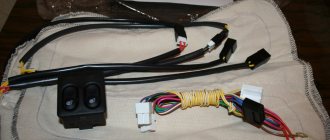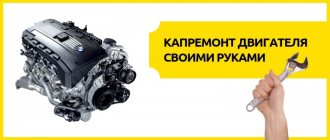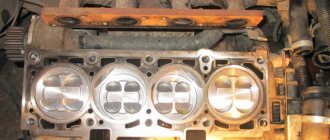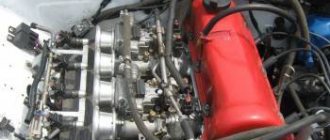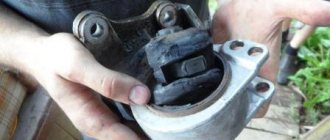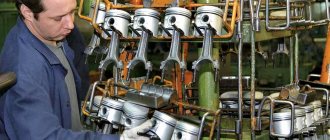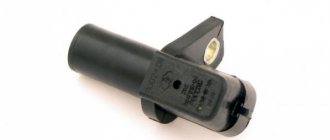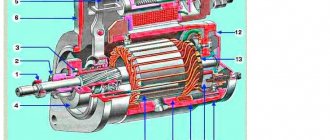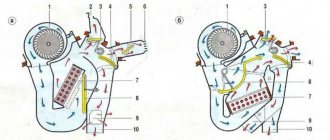What is this?
Engine overhaul refers to the work of a master aimed at returning the engine to a state as close as possible to its original state. In this case, most of the nodes are changed or restored. This type of repair is resorted to when there is a lot of wear on the parts of the unit.
The list of work may include grinding the crankshaft journal and camshaft, installing new pistons and springs, and honing the cylinders. If too many engine components are faulty, then it is more advisable to completely replace it.
The following signs indicate that it is time to overhaul the engine on the VAZ-2114:
- The appearance of red, black or dark gray carbon deposits on the spark plugs.
- Increased oil consumption.
- The occurrence of knocking in the engine.
- Increased fuel consumption.
- The appearance of smoky exhaust.
- Bad traction.
- Engine overheating.
- At idle, the engine runs unevenly.
- Reduced power.
Stages of engine repair
Rebuilding the engine involves performing the following actions:
- Removing the motor.
- Complete disassembly and removal of accumulated dirt by washing and cleaning.
- Identification of defective spare parts of the block that need to be replaced: inspection of the engine block for cracks, measurement of possible gaps formed, assessment of the condition of the crankshaft, identification of worn parts.
- Overhaul of the cylinder head.
- Restoration of the cylinder block.
- Assembly of the unit and installation on the car.
Disassembly and dismantling of the engine
The process of removing the unit from the car may vary depending on the car model. Dismantling a carburetor engine is much simpler than an injection engine. There are fewer electronics that have to be removed first. Also, the disassembly process will be different for brands with front and rear wheel drive.
The preparatory stage preceding dismantling will be the removal of interfering mechanisms and unscrewing the retaining bolts. The removal of a heavy unit from the car body occurs using a special lift or winch. If there is no such device, then to reduce weight, all possible parts and spare parts of the engine are removed, and it is pulled out manually. This will require the help of several people.
Disassembly follows. The work should be done sequentially, carefully inspecting the parts for wear and placing them in order.
It is worth knowing that a VAZ engine can be disassembled in about 3 hours; disassembling a foreign-made engine takes more time: about 10 hours.
Washing engine parts
Washing is an important step that many people skip.
It is not right. Each detail has a specific meaning. If the spare parts are not washed and deposits are not removed, then the degree of wear can be incorrectly determined, which can cause rapid failure of the entire motor. You should also wash the block and cylinder head with special care to examine for possible cracks.
Diagnosis of damage and defects
Defects are identified visually and using measuring instruments. All spare parts are checked for wear, scratches, cracks and chips. Particular attention should be paid to the following details.
- The cylinder block and head are checked for integrity, special attention is paid to cracks and chips.
- The crankshaft is inspected and measured to check whether wear has appeared, and is also checked for alignment and bends.
- Parts of the connecting rod and crank mechanism: the general condition and the presence of play are determined.
- Gas distribution mechanism.
Cylinder head repair
Repairing this spare part is not too complicated, but many car owners turn to the service for help. If you decide to do the repairs yourself, then you will need to replace or repair the following parts.
- Camshafts.
- valves.
- Guide bushings.
- Valve stem seals.
If cracks are found on the block head, it will need to be replaced or polished. It is possible that there will be a specialist who can weld the damage with argon.
Cylinder block repair
After cleaning and washing the block, it is necessary to restore it, bringing it to a quality close to the factory one. It is necessary to polish the head seat to a mirror shine, eliminating any existing holes and chips. For this, a surface grinder or milling machine is used. Depending on the degree of damage, the cut thickness can vary from 0.05 mm to 1 mm. If there are too deep cavities, grinding may consist of several stages.
Crankshaft repair and restoration
A car's crankshaft can be repaired and bored a certain number of times, depending on the model. For example, the crankshaft on a VAZ needs to be repaired 4 times and is bored to fit different sizes of liners with their subsequent enlargement. Having dismantled the spare part, the first thing you need to check is whether it can be restored. If yes, then you can buy larger earbuds and get started.
The second thing you need to pay attention to is the crankshaft journals. If, upon inspection, wavy grooves and risks are found on them, then you need to get rid of them. This is done by grinding on a special machine. Remember the main thing! Replacing liners without grinding is unacceptable. Repairing a car engine with your own hands will be in vain, the result will be zero.
Assembly and installation of internal combustion engines
Having prepared the head, cylinder block and crankshaft, we proceed to assembling the engine. For engine capitalization, you may need to purchase the following spare parts from a car store:
- Valves, guide bushings and seats for them;
- Connecting rod and main bearings;
- Connecting rod pins and bushings for them;
- Piston rings;
- Repair kit for pump;
- Oil filter;
- Gasket set.
Engine assembly occurs in the following order:
- Installation of liners and crankshaft shrinkage.
- Installation of pistons and connecting rods.
- Fixing the crankshaft with yokes.
- Installing the gasket.
- Installation of the motor cover.
- Mounting the pump and oil pump.
- Installing the crankshaft pulley.
- Installing the head.
- Fastening the pan and crankcase.
When installing the liners and piston group, lubricate the parts and cylinder walls with a special lubricant. Its further performance and service life depend on the high-quality assembly of the internal combustion engine. It is advisable that it be carried out by a person who knows the principles of operation and the design of the motor.
We install the unit in its original place using a lifting device. After successful installation, it is fastened, then the removed equipment and electrics are installed in reverse order. Before starting the engine, it is additionally recommended to center the clutch and test the engine.
Running in the engine
Having capitalized the engine, you definitely need to break it in properly.
Otherwise, the motor will quickly fail without using up even half its service life. During the break-in period, parts are ground in, and excessive load will harm them. According to existing standards, a car needs to be run in for about 2-3 thousand km. In this case, the speed should not exceed 60 km/h.
What is this?
Engine overhaul refers to the work of a master aimed at returning the engine to a state as close as possible to its original state. In this case, most of the nodes are changed or restored. This type of repair is resorted to when there is a lot of wear on the parts of the unit.
The list of work may include grinding the crankshaft journal and camshaft, installing new pistons and springs, and honing the cylinders. If too many engine components are faulty, then it is more advisable to completely replace it.
The following signs indicate that it is time to overhaul the engine on the VAZ-2114:
- The appearance of red, black or dark gray carbon deposits on the spark plugs.
- Increased oil consumption.
- The occurrence of knocking in the engine.
- Increased fuel consumption.
- The appearance of smoky exhaust.
- Bad traction.
- Engine overheating.
- At idle, the engine runs unevenly.
- Reduced power.
Major repairs proceed approximately according to this scheme:
- Preparing the engine for dismantling (disconnecting wires, hoses, gearbox).
- Removing the engine.
- Removal and inspection of the cylinder head.
- Disassembling the unit for diagnostics and cleaning.
- Block boring. Grinding the crankshaft. Application of hone to the cylinder walls.
- Weight distribution of connecting rods, pistons.
- Block assembly.
- Restoring the head (replacing caps and guides, straightening seats).
- Assembling the engine and installing it in the engine compartment.
- Connection.
- Functionality check.
Approximate price
On average, a major overhaul of a VAZ-2114 engine costs from 22,000 rubles.
Engine repair cost broken down:
- Dismantling – 500 rubles .
- Installation – 600 rubles .
- Replacing oil scraper caps - 2000-4000 rubles .
- Pulling the engine sump - about 490 rubles .
- Crankshaft grinding - from 900 rubles .
- Replacing the crankshaft bearing - about 330 rubles .
- Honing and boring on a standard block - from 1000 rubles .
- Replacing the valve cover - 420-620 rubles .
- Replacement of the engine mount - from 540 rubles .
VAZ 2110 engine repair
The advantage of power units of Russian cars is that there is a lot of information about the features of engine repair. This allows you to repair the VAZ 2110 engine yourself.
Engine block restoration
Today in Russia the most popular is the “ten” with an 8-valve injection engine with a working volume of 1.5 liters. The VAZ 2110 injection engine runs only on gasoline, 4 cylinders are located transversely.
Types of repairs
Depending on what fuel the VAZ-2114 engine runs on, major overhauls are distinguished:
- A unit operating on gasoline.
- Diesel engine.
From the one who carries out the work, major repairs happen:
- Independent.
- Auto service specialist.
- A private craftsman who works in his garage.
Major repairs are identified according to urgency:
- Urgent.
- Not urgent.
Location of the number on the VAZ-2114 engine
During the manufacture of a VAZ-2114 car, workers at the Volzhsky Automobile Plant knock out the engine identifier in a clearly marked place. The number is located directly on the cylinder block. You can find it on the right, near the thermostat. It is stamped slightly above the clutch housing and a couple of millimeters below the VIN code.
So that nothing interferes with the comparison process, it is advisable to dismantle the air filter from the VAZ-2114 along with the lines leading to it. You won't have to touch the rest of the engine.
The identifier is stamped out with a special machine, which is why the inscription appears to be embedded in the thickness of the metal. This method allows you to make data virtually indestructible. In the indicated place, nothing can create conditions under which the numbers could be damaged or even partially lose readability.
In addition, there is a special tin information plate in the engine compartment. It is also installed at the factory and secured with rivets. Here is a duplicate of not only the number of the power unit, but also the body. It also contains other important information, such as:
- Business name;
- year of issue;
- mass, etc.
The mentioned plate is also important, therefore it should be protected from damage and kept in perfect order. It is recommended to periodically clean the tag from dirt and rust. Its location is the right edge of the front beam.
Disassembly and repair of the VAZ 2110 engine
Video on overhaul and engine assembly of a VAZ 2112 car, as well as detailed instructions with photo support for disassembling a VAZ 2110 engine.
Repairing a VAZ 2110 engine, like any other car model, is not an easy job, but it can still be done. If you know even a little about technology, you will be able to do it. To carry out repairs, you must at least disassemble the engine. We bring to your attention a hint on how and in what sequence to perform such work.
Motor maintenance
When the design and main technical characteristics inherent in the VAZ 2114 engine have been reviewed, it is necessary to consider maintenance and provide answers to questions that motorists are increasingly asking.
Maintenance
If you believe the plant, the manufacturer, the VAZ 2114 engine must be serviced every 12-15 thousand kilometers. It depends on what marking the motor is installed on the vehicle. Maintenance scheme for all engines installed on the “fourteenth” model:
- At the first maintenance, the oil, oil filter and air filter element are replaced, as well as the functionality of all systems is checked.
- The second maintenance is done after 12,000 km. In this case, it is necessary to change the oil and oil filter element.
- Third maintenance – 25,000 km, replacing not only the oil, but also the air filter, and ongoing repair of faults.
- After 45,000 km, it is necessary to replace the timing belt and roller so that the VAZ 2114 engine does not have to be overhauled.
GENERAL INFORMATION AND ENGINE DIAGRAM
The VAZ 2114 engine, in comparison with the power units of classic VAZs, has one key difference - a fuel injection system, the operation of which is controlled by an ECU (electronic control unit).
Due to the fact that the electronics takes into account all the important nuances: the ratio of gasoline and oxygen in the fuel mixture, the required injection timing and the composition of the exhaust gases, the engine of the fourteenth performs at its best - it is durable, powerful and economical.
The 2111 engine is an 8-valve, 4-cylinder device with four strokes. The cylinder arrangement is in-line. The engine itself in the engine compartment is placed perpendicular to the direction of movement of the car.
The VAZ 2114 engine diagram looks like this:
ICE
- Tube for supplying cooling mixture;
- BC (cylinder block);
- Thermostat;
- Sensor that determines the temperature of the cooling mixture;
- Outlet pipe;
- BC valve;
- BC cover;
- Fuel mixture pressure sensor;
- Oil container cover;
- Throttle activation cable;
- Throttle block;
- Device that regulates idle speed;
- Sensor that determines the position of the throttle valve;
- Receiver;
- Rear part of the housing of the gas mixture distribution unit;
- Front part of the body;
- Fuel injectors;
- Fuel rail plug;
- Fuel rail;
- Gasoline intake manifold;
- Intake manifold support (right);
- Pulley;
- Oil filter;
- Sensor that determines the position of the crankshaft;
- Crankcase bottom;
- Intake manifold;
- Connecting rod;
- Crankshaft;
- Collector support (left);
- Flywheel.
Vehicle identification numbers VAZ-2114
Location of identification numbers in the engine compartment:
1 — vehicle identification number; 2 - summary plate with vehicle nameplate data; 3 — engine number (at the end of the cylinder block under the thermostat housing)
According to existing legislation, each vehicle has an identification number (VIN code).
This number is recorded in
the vehicle passport
(PTS). The identification number and other passport data of the vehicle are indicated in the summary plate.
An identification number
stamped on the body in two places: in the engine compartment on the amplifier (support cup) of the right mudguard.
Summary plate:
1 — number for spare parts (corresponds to the serial number of the car that came off the assembly line); 2 — vehicle type approval number; 3 — identification number (XTA — manufacturer code; 211440 — car model; 6 — year of manufacture; last seven digits — body number); 4 — engine model; 5 — load on the front axle; 6 — load on the rear axle; 7 — codes of vehicle version and configuration; 8 - maximum permissible vehicle weight; 9 - maximum permissible weight of the vehicle with trailer
Note. The model year of manufacture can be indicated by a number or a letter of the Latin alphabet (see Table 1.1).
. and on the luggage compartment floor reinforcement next to the spare wheel mounting bracket.
The engine number is stamped on the end of the cylinder block above the clutch housing (under the thermostat housing).
To read the number, you must remove the air filter housing.
Disassembly and assembly of the engine on VAZ 2113, 2114, 2115 cars
After dismantling, we install the engine on a disassembly stand. We remove the generator, cylinder head, upper clutch housing cover, flywheel and oil pump. Using a 10mm wrench, unscrew the two bolts securing the supply pipe of the coolant pump. Remove the pipe and gasket.
Using a 10mm wrench, unscrew the six bolts securing the crankshaft rear oil seal holder.
Remove the holder and gasket.
Using a 14mm socket, unscrew the nuts securing the connecting rod cover (the connecting rod must be at BDC).
Remove the lower connecting rod bearing shell from the cover.
We rest the wooden handle of the hammer against the connector of the lower head of the connecting rod and push the piston and connecting rod out of the cylinder.
Remove the upper bearing shell from the connecting rod head a.
Similarly, we remove the pistons with connecting rods from other cylinders. We clamp the connecting rod in a vice with soft metal pads.
Using your fingers, carefully (without exerting much force) open the locks of the piston rings and alternately remove two compression rings and one oil scraper ring from the piston. Remove the oil scraper ring expander.
On the VAZ-21083 engine, the piston pin is inserted into the upper head of the connecting rod with interference.
We press out the pin by hitting the mandrel with a hammer, holding the connecting rod hanging or placing the piston in a wooden support with a cylindrical recess for the piston skirt and a hole for the pin.
The VAZ-2111 engine uses floating-type piston rings that rotate freely in the piston bosses and connecting rod bushing. To disassemble the piston and connecting rod, clamp the connecting rod in a vice with soft metal pads. Use a screwdriver to pry up the piston pin retaining ring and remove it from the piston ring groove.
In the same way, remove the second retaining ring. Use a mandrel to push out the piston pin and remove the piston from the upper head of the connecting rod.
Using a 17mm socket, unscrew the ten bolts securing the crankshaft main bearing caps.
VAZ 2114 engine modifications
Over the ten years of serial production of the VAZ 2114, the following was installed on it:
- 1.5i . Engine VAZ 2114 with a volume of 1.5 liters, with 8 valves. Its maximum power was 78 hp. C. at 5800 rpm. Torque at 3800 rpm reaches 116 N.m. Per 100 km in the mixed cycle, gasoline consumption is 7.3 liters. In this modification of the internal combustion engine, an injection intake with control through the electronics was used, instead of the outdated carburetor, and a new camshaft with corrected phases was installed. Thanks to the introduction of an injector into the VAZ 2114 engine, engineers were able to increase the efficiency of the engine, increasing its power, and at the same time reducing fuel consumption. This was a big starting step in the development of the entire range of internal combustion engines of the Volzhsky Automobile Plant.
- 1.6i . In 2004, a modification of the engine was released with an increased volume of 1.6 liters. It developed a power of 81 hp. With. at 5200 rpm and 125 N.m. at 3000 rpm. In the combined cycle, the engine consumes 7.6 liters of gasoline per 100 km. The VAZ 2114 engine with an injector and 8 valves received an increased volume due to the cylinder height increased by 2.3 mm, which made it possible to make a larger piston stroke. The ignition module was replaced by a coil. The internal combustion engine turned out to be more powerful and environmentally friendly, but fuel consumption increased compared to the previous model.
- 16V 1.6і (124) . Also in 2004, a 1.6-liter engine was released, but with 16 valves, that is, 4 for each cylinder. This engine already had 89 horsepower at the flywheel at 5000 rpm and 131 Nm of torque at 3700 rpm. The plant claims consumption in the combined cycle of 7.5 liters per 100 km. The VAZ 2114 8-valve engine with an injector received modifications in the form of an increase in the number of valves to 16 pieces. The rest of the characteristics remain the same. The car began to meet EURO-3 environmental requirements, gained an additional 8 horsepower and became a little more economical.
- 16V 1.6і (126) . In 2007, this engine was greatly modified, the volume remained the same 1.6 liters, but the power already reached 98 hp. With. at a speed of 5600 per minute, and the torque develops 145 N.m. at 4000 rpm. Fuel consumption was reduced to 7.2 liters per 100 km.
They worked hard on the old VAZ 2114 engine for 3 years and made several changes:
- the connecting rod and piston group is lightened by 39%;
- The timing drive has been changed, it has become automatically tensioned;
- valve holes have decreased in size;
- The quality of cylinder honing has improved significantly.
All these and some less significant modifications increased the torque of the engine and now it developed 98 hp. With. and had a peak torque of 145 N.m. At the same time, fuel consumption has significantly decreased. This internal combustion engine turned out to be the most successful of all and became a great advantage of the cars equipped with it.
What is the service?
The engine is the key part of the car. Without it, it will not be able to perform its main function as a means of transportation. If the engine breaks down, there is a risk of losing control of the car on the road, so repair or replacement of this part should be carried out immediately when a malfunction is detected.
Carrying out a complete diagnosis and major repair is not so easy and it is not done everywhere. Especially when you consider that the car model is not the most common and certainly not a new product. Although there are skilled handicraftsmen who can carry out major repairs for a very modest fee, none of them can guarantee the quality. In addition, you will still have to pay extra for replacing engine components, so the savings in the end will not be so significant.
VAZ 2114 engine: design, repair, tuning
The VAZ 2114 injector engine is a series of engines that were installed on the Lada 2114 vehicle. Like many Lada models, the 2114 model received several power unit options over all years of production. So, the technical characteristics of each of them were different. Let's consider the design of the 2114 engine, as well as issues of maintenance, tuning and repair.
Specifications
VAZ 2114 car
The technical characteristics of the VAZ 2114 engine are quite typical for the 2113-2115 series of cars. In addition, this power unit is developed on the basis of the “eight” engine, which has declared itself to be reliable and easy to repair. The car was produced from 2001 to 2013. During this period, the vehicle received five valuable power units.
VAZ 2114 engine structure
As was said earlier, the 2114 was equipped with five different power units, which differed in power and valve mechanism. Three of them had 8 valves, and the other two had 16. The gas distribution mechanism had a belt drive. Until 2007, the engine was equipped with a simple on-board computer, which did not regulate the operation of the engine based on sensor readings. Therefore, the motorist had to regulate the processes the old fashioned way, manually. Since 2007, an ECU was installed, which, receiving data from sensors, independently adjusted many processes.
Design features of the engine.
Since the second generation had a so-called two-way electronic engine control unit, it is worth considering what electrical circuit was installed.
Electrical diagram of a VAZ 2114 car.
Main characteristics of the motor
All engines that were installed on the vehicle had approximately the same characteristics and design features. So, the motor is easy to service and repair with your own hands. Let's look at the main technical characteristics of the VAZ 2114 engine:
VAZ 2111
| Name | Index |
| Volume | 1.5 liter (1499 cm3) |
| Number of cylinders | 4 |
| Number of valves | 8 |
| Fuel | Petrol |
| Injection system | Injector |
| Power | 77 hp |
| Fuel consumption | 8.2 l/100 km |
| Cylinder diameter | 82 mm |
VAZ 21114
| Name | Index |
| Volume | 1.6 liter (1596 cc) |
| Number of cylinders | 4 |
| Number of valves | 8 |
| Fuel | Petrol |
| Injection system | Injector |
| Power | 81.6 hp |
| Fuel consumption | 7.6 l/100 km |
| Cylinder diameter | 82 mm |
VAZ 11183
| Name | Index |
| Brand | 11183 |
| Marking | 1.6 8V |
| Type | Injector |
| Fuel | Petrol |
| Valve mechanism | 8 valve |
| Number of cylinders | 4 |
| Fuel consumption | 9.6 liters |
| Piston diameter | 82 mm |
| Resource | 200 – 250 thousand km |
VAZ 21124
| Name | Index |
| Volume | 1.6 liter (1599 cc) |
| Number of cylinders | 4 |
| Number of valves | 16 |
| Fuel | Petrol |
| Injection system | Injector |
| Power | 89.1 l.
|
| Fuel consumption | 7.0 l/100 km |
| Cylinder diameter | 82 mm |
VAZ 21126
| Name | Index |
| Volume | 1.6 liter (1597 cc) |
| Number of cylinders | 4 |
| Number of valves | 16 |
| Fuel | Petrol |
| Injection system | Injector |
| Power | 97.9 hp |
| Fuel consumption | 7.2 l/100 km |
| Cylinder diameter | 82 mm |
Engine VAZ 2114.
All engines were equipped with 5-speed manual transmissions. Engine volume ranges from 1.5 to 1.6 liters. This car was not equipped with a large power unit. The average engine power of the VAZ 2114 is 85 horsepower.
Motor maintenance
When the design and main technical characteristics inherent in the VAZ 2114 engine have been reviewed, it is necessary to consider maintenance and provide answers to questions that motorists are increasingly asking.
Maintenance
If you believe the plant, the manufacturer, the VAZ 2114 engine must be serviced every 12-15 thousand kilometers. It depends on what marking the motor is installed on the vehicle. Maintenance scheme for all engines installed on the “fourteenth” model:
- At the first maintenance, the oil, oil filter and air filter element are replaced, as well as the functionality of all systems is checked.
- The second maintenance is done after 12,000 km. In this case, it is necessary to change the oil and oil filter element.
- Third maintenance – 25,000 km, replacing not only the oil, but also the air filter, and ongoing repair of faults.
- After 45,000 km, it is necessary to replace the timing belt and roller so that the VAZ 2114 engine does not have to be overhauled.
Subsequent maintenance is carried out in accordance with 2 and 3 maintenance.
Frequently asked questions and their answers
The process of repairing a VAZ 2114 engine.
Many car enthusiasts on forums ask the same questions. Let's try to classify all of them, and also give answers according to factory standards and recommendations.
What kind of oil should be poured into the VAZ 2114 engine?
If you rely on the manufacturer’s data, then different oil is poured into the VAZ 2114 engine, depending on the type. So, what kind of oil should you put in the VAZ 2114? If you take it for an 8 valve engine, then ideally it would be suitable with the 10W-40 marking. If it is a 16 valve engine - 5W-30. In any case, the oil for the VAZ 2114 should be semi-synthetic.
What is the operating temperature of the engine?
Based on the manufacturer's data, the operating temperature of the motor for engines installed on models 2113-2115 is 87-103 degrees Celsius. After 105 degrees the electric fan turns on.
Where is the engine number on the VAZ 2114?
The engine number is quite easy to find. It is located on the gearbox side, near the thermostat. The engine number always has a pad on the cylinder block, which is located in a visible place.
What is the resource of ICE 2114?
The service life of the VAZ 2114 engine is 150 thousand km for an eight-valve power unit and 180,000 km for a 16-valve power unit. To extend the service life, you need to know what oil to pour into the engine, as well as service it on time. Although driving style and careful operation of the car play an important role.
Do valves bend on VAZ 2114 engines?
Of course, like in any other engine, the VAZ 2114 has a valve mechanism that bends. This often happens due to overheating, when the head bends. The valves can also bend if the timing belt breaks.
What to do if the engine does not develop power and the speed drops?
In this case, it is worth carrying out a comprehensive diagnosis of the power unit.
The issue may lie either in the inoperability of one of the sensors or in the mechanics. You can find the problem on your own or with the help of professionals at a car service center.
Where and from whom can I order the service?
If an engine overhaul of a VAZ-2114 is required, then there are several options:
- Take the car to a car service center.
- Contact a private master.
- Repair the unit yourself.
A major type of repair requires extensive knowledge, skills, experience, certain equipment and tools. Therefore, only a master of a service center can carry out a high-quality engine restoration. Car service centers issue a warranty certificate. You should contact private traders only on the advice of good friends. Among such workers there are often low-skilled people. In addition, they do not provide a warranty card.
On cars of the Samara 2 series, the Volzhsky Automobile Plant installed injection engines with electronic, distributed fuel injection. And for the VAZ 2114, which appeared in 2001, and was launched into series in 2003, such a power plant was developed - model 2111. In subsequent years, various modifications of this car were produced and some of them were equipped with other engine models, such as - 21114, 11183, 21124 and 21126. But the most popular production cars were the VAZ 2114 with engines of models 2111 and 11183.
